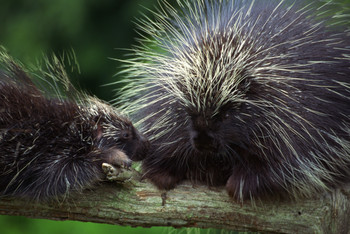

| HOME | ANIMALS | CONSERVATION | RESOURCES | DIRECTORY | SITE MAP |
Dr. Sacha Spector on saving "the other 99 percent" - At The Museum - invertebrate conservation - Interview
Q: What exactly are invertebrates, and why should people care about them? Invertebrates are united by what they don't have, namely backbones, rather than any shared features. If you think of the evolutionary "Tree of Life" of animals, vertebrates--mammals, birds, reptiles, etc.--make up only a single branch. All the other animal branches are invertebrates. So invertebrates really represent the vast majority of evolutionary history on Earth. While people mostly think of insects, invertebrates actually encompass a huge range of animals found on land and in water. Some of these we're quite familiar with, like squid, lobsters, corals, and jellyfish, but there's a whole universe of lesser-known invertebrates out there, like tardigrades or "water bears," chitons, and flatworms. As a group, invertebrates probably constitute 99 percent of all animal life on Earth, so we share this planet with millions of invertebrate species. Invertebrates are essential elements of every ecosystem--hey fill niches as herbivores, carnivores, parasites, and decomposers. They also serve as food for mammals, birds, fish, reptiles, amphibians, other invertebrates, and even carnivorous plants! Ecosystem services provided by invertebrates--such as pollination of crops, soil creation and aeration, decomposition, and seed dispersal--are estimated to be worth trillions of dollars to our economy each year. It is said that over one third of the human diet depends directly or indirectly on pollination by insects. Q: Invertebrates seem to surfer from an image problem ... some elicit fear, while others are seen as pests. Usually, we fear things we don't understand. One of my favorite things is getting kids to look at insects with a microscope--one look at the metallic colors of a beetle or the reflections from a fly's eye and the "eeewww" usually turns into "cool!" As for pests, only a tiny percentage of invertebrates are injurious, and those we're most familiar with are generally non-native species introduced by humans, such as the gypsy moth, Japanese beetle, and some types of cockroaches. But every organism has its function in the web of life--even mosquitoes. Mosquito larvae are an important food source for fish and other aquatic creatures, and the adults feed a lot of birds and bats. Q: What drew you to the study of invertebrates? My interest in invertebrates hit me later in life. In fact, I went off to college wanting to become a professional trombonist. But I was also very concerned about the environment, and I've always loved the outdoors, so I eventually changed my major to biology. (Also, I quickly realized I would never make a great trombonist.) I did a few insect-related projects as an undergraduate, and the more I delved into biodiversity research, the more I realized that invertebrates were being left out of the majority of conservation efforts. My current research is related to addressing this issue. Because invertebrates as a whole are so numerous and diverse, and most groups are poorly understood, I'm working on designing approaches to choosing a few invertebrate groups about which we can quickly compile as much data as possible, and then use those groups as "information surrogates" for invertebrate conservation planning. Q: Are invertebrates facing the same threats and endangerment as mammals, fish, and other species? Absolutely. The three most endangered groups of organisms in the United States--freshwater mussels, crayfish, and stoneflies--are all invertebrates. Widespread threats such as habitat loss, introduced species, and pollution, are rapidly driving many invertebrate species to the edge of extinction. Part of their plight lies in their very diversity--how do you plan and manage communities of organisms when you aren't sure what (or how many) you're dealing with? This is one of the major questions that we will be looking at in the Expanding the Ark symposium. Q: What can we do as individuals to help conserve invertebrates? There are important things you can do every day. Pesticides, which often kill many other organisms besides the target pest, are a major threat to invertebrates, so one major thing everyone can do is to support farming without chemical pesticides by choosing organic foods. In the suburbs and rural areas, light pollution is a concern as it attracts insects away from their habitats, disrupts their egg laying, mating, and feeding, and also makes them more susceptible to predation. You can reduce or eliminate outdoor lights or, if necessary, install motion detectors or use yellow lights that don't attract insects. But probably the most important thing you can do is to learn about the invertebrates that live in your area. We save what we care about, so the first step is just getting out there and learning to love the fascinating and often beautiful creatures all around us. |
Copyright 2025 Euregio-wald.com All rights reserved.
|
 Sacha Spector is Invertebrate Conservation Program Manager with the Museum's Center for Biodiversity and Conservation (CBC). We caught up with Sacha in his invertebrate lab at the Museum, as he is busy gearing up for the CBC's March symposium, Expanding the Ark: The Emerging Science and Practice of Invertebrate Conservation.
Sacha Spector is Invertebrate Conservation Program Manager with the Museum's Center for Biodiversity and Conservation (CBC). We caught up with Sacha in his invertebrate lab at the Museum, as he is busy gearing up for the CBC's March symposium, Expanding the Ark: The Emerging Science and Practice of Invertebrate Conservation.